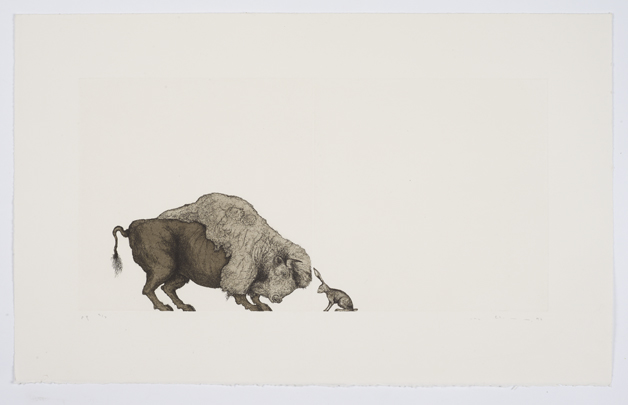
1996
hard-ground etching and aquatint on Rives BFK paper, printed by Vinalhaven Press
11 x 22 inches
edition of 25
A face-off between two aspects of the artist.


1996
hard-ground etching and aquatint on Rives BFK paper, printed by Vinalhaven Press
11 x 22 inches
edition of 25
A face-off between two aspects of the artist.


Topography and Calligraphic Organs of ULSAN ECO Park (Korea)
1996
photo-copy document, ink on Asian paper
25 3/8 x 24 3/8 inches

Park as Five Element Body
1996
graphite, marker, and ink on layered canary tracing paper
48 x 21 inches
In Topography and Calligraphic Organs of ULSAN ECO Park (Korea) and Park as Five Element Body, Confucian philosophic interpretations of five-element theory are applied to landscape design. Five-element theory is a system of Chinese holistic thought, which includes medicine. Organs of the body are in constant interaction and are represented as fire, earth, metal, water, and wood, in cycles of creation and destruction. Chin postulates a non-western ecological park as an entity with functioning organs and users as the circulating energy (chi) of the landscape. The drawings were presented as concepts for an ULSAN ECO Park design group in South Korea in 1996.


1996
wood, gold leaf, mirror
4 x 7 x 1 3/4 inches
“From a dream. I was at the party but I was blind wearing a plain mask. I took off the mask and the interior was carved and my eyes were reflected in mirrors.”


1996
offset rubber ink over mixed media
edition of 1200 installed floor to ceiling
each 20x 16 inches
There are no losers in Scratch . . . a special art project taking the form of a collaborative multiple, organized for a fund-raising event and leaving each paying player with a rare artifact contextual to our times.
Scratch is derived from instant prize scratch-off games with their silver veils begging to be rubbed away to reveal riches. The current proliferation of this simple, interactive game has lead a New York State Lottery public affairs agent to proclaim it as the area in the lottery system with the “greatest potential for growth.”
Scratch is a project that questions the psychology of instant gratification and gain without pain while also addressing the system of art exhibition marketing and conservative politics which has forced many alternative venues to rely on artists’ donations for fundraising. In this case, the art concept will guarantee that each participating collaborator will be paid for her/his contribution with a Scratch card. There will be real winners but no losers as each card is a genuine art multiple with intrinsic value.
SCRATCH forces a choice between CULTURE and CASH,
the MARKED and the VIRGINAL,
the SCUFFED and the UNSCATHED,
the RAW and the PRISTINE



John Baldessari card


1996
hard and soft-ground etching, engraving, photoetching and lithograph on Arches Cover paper, printed by Vinalhaven Press
edition of 20
30 x 30 inches
Revival Ramp is based on a drawing Chin created while installing eco-related artworks in Munich, Germany. The image traces possible courses of ecology on a spiraling “ramp” of time: starting with Leonardo Da Vinci’s A Copse of Trees (c. 1500), ascending through the industrial revolution, and trifurcating into three futures. The history of a hyperaccumulator plant is ever present, from it’s naturally occurring place to its use to detoxify polluted land. At a critical bend in the ramp, in contemporary time, Revival Field is sited. Afterwards the scenarios of a better, greener world “reviving” the trees of Leonardo, or of an alternate path moving to an industrial wasteland or an unknown bleak future with a black sun, are projected.


1995
stone, stainless steel, sandblasted glass
For the City of New York, School Construction Authority Long Island City High School, Queens, New York
Linking geography with human scientific and cultural invention, the artist uses topographies, contours, elevations and scale relationships to transform this sculpture into a “mine” of meanings. This project starts at the main entrance of Long Island City High School, with two large, triangular, granite ramps flanking the doorway that topographically depict two specific places – an overhead view of the city blocks in New York City that surround and include the school, and the Olduvai Gorge in East Africa. These pieces, suggestive of middens, present the archeological pasts of the two regions as “areas of invention.” The capitals of the entrance columns are clad in three stainless steel relief panels representing prehistoric icons and their modern technological counterparts, such as a flint stone and an electric filament, or a prehistoric female icon and a Muybridge image.
The ceremonial staircase in the lobby has a series of cast stainless steel finials, each representing a specific mountain range, and the glass panels along the railing are etched with ornamental patterns referring to the cultures related to each mountain finial. Each step has a direct scale relationship to the selected mountain range, so that one passes various places and cultures, from the Appalachians to the Himalayas, while ascending or descending the staircase.
The artist seeks to provoke the students’ sense of investigation and discovery. The artworks can stand on their own, as aesthetic forms evoking “poetic” readings, but they are also configured to encourage further research. Interested students can find a key in the library prepared by the artist that deciphers these varied landscapes and iconographies using historical references





